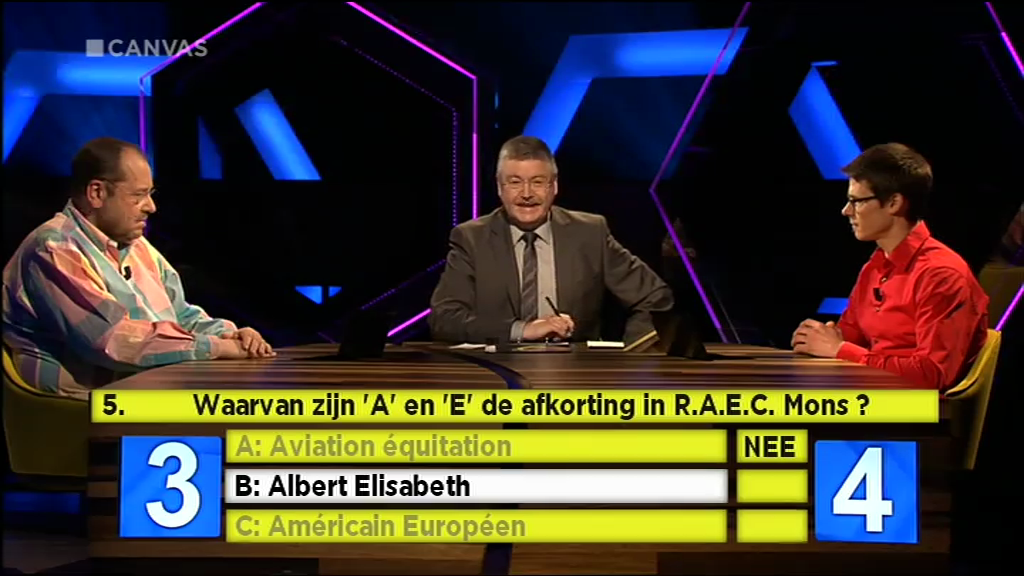From 2001 to 2014 the Belgian television channel Canvas was broadcasting the legendary television quiz De Canvascrack. The show was built around the idea that one participant — the crack — competes against a challenger in a short quiz of five multiple choice questions on various subjects, with three possible answers per question. The questions often contained multiple clues from which the correct answer could be derived, either directly or by elimination. Once per show, a round had a set of five questions with a common theme.

In each round, the challenger first answered each of the multiple choice questions aloud. After each answer of his challenger, the crack indicated whether or not he thought his opponent had given the correct answer using a pair of hidden buttons. An evaluation followed after each question round, in which both the correct answers and the assessments of the crack were given. The challenger won a point for each correct answer given and the crack won a point for each correct assessment. The total number of points won in a single round decided if the crack won or lost, or if the round ended in a tie.
Each challenger was seated at a different table. After each win, the crack moved on to the next table to take up against the next challenger. Each successive table was a fixed amount of €25 worth more than the previous table: the first table was worth €25, the second €50, the third €75, and so on. After each table won by the crack, the value of that table was added to his total amount. In addition, after each fifth table won the total amount won by the crack was doubled (after the value of the fifth table won was added to the total amount).
After each table won, the crack could decide to stop and take home the total amount he had won so far. He could also decide to move on to the next table, taking the risk to lose money there. Upon losing a table, the total amount won by the crack was halved and the crack was replaced by the challenger that had just beaten him. After having won twenty tables, a crack was forced to stop and take his total amount home.

The table below shows the development of a game where the crack wins 20 tables in succession. It indicates the value of each successive table (second column), whether the total amount is doubled after winning this table (this happens at tables 5, 10, 15 and 20; third column) and the total amount the crack has earned after winning the table (fourth column).
| table | value | double | profit |
|---|---|---|---|
| 1 | €25 | €25 | |
| 2 | €50 | €75 | |
| 3 | €75 | €150 | |
| 4 | €100 | €250 | |
| 5 | €125 | ✓ | €750 |
| 6 | €150 | €900 | |
| 7 | €175 | €1075 | |
| 8 | €200 | €1275 | |
| 9 | €225 | €1500 | |
| 10 | €250 | ✓ | €3500 |
| table | value | double | profit |
|---|---|---|---|
| 11 | €275 | €3775 | |
| 12 | €300 | €4075 | |
| 13 | €325 | €4400 | |
| 14 | €350 | €4750 | |
| 15 | €375 | ✓ | €10250 |
| 16 | €400 | €10650 | |
| 17 | €425 | €11075 | |
| 18 | €450 | €11525 | |
| 19 | €475 | €12000 | |
| 20 | €500 | ✓ | €25000 |
A crack that managed to win 20 tables could call himself Supercrack and received the first prize of €25,000. Only seven participants accomplished this: Jan Van den Nest (2002), Jimmy Geeraerts (2005), Jan Bosmans (2006), Joris Alen (2007), John Christoffels (2008), Erik Meersschaert (2009) and Geert Tanghe (2014).
Assignment
Decide based on the run of the game in a question round of De Canvascrack, whether the challenger or the crack wins the round.
Input
The first line contains a number $$n \in \mathbb{N}_0$$ indicating the number of questions in the round. This is followed by another three lines for each question, containing the following information:
-
the correct answer to the question: A, B or C
-
the answer given by the challenger: A, B or C
-
the assessment of the crack on the answer given by the challenger: correct or wrong
Output
The crack loses if his total score is less than half of the number of questions in the round. Otherwise the player with the highest total score wins, or the round ends in a tie if both the challenger and the crack score the same amount of points. Depending on the evaluation of the run of the game as described by the information in the input, the following output must be generated:
-
crack wins: crack wins c points against o
-
challenger wins: challenger wins o points against c
-
tie: ex aequo: both contestants score o points
The fragments in italic have to be filled up based on the computed total scores: c is the total score of the crack and o is the total score of his opponent.
Example
Input:
5
C
C
correct
B
C
wrong
B
A
correct
A
A
wrong
C
A
wrongOutput:
crack wins 3 points against 2Example
Input:
5 C C correct A A correct A A correct B A correct A B correct
Output:
ex aequo: both contestants score 3 points
Example
Input:
5 A A correct B B wrong A C correct C C correct C C correct
Output:
challenger wins 4 points against 3